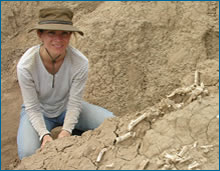
Understanding Evolution research profiles are a rich resource for instructors. These illustrated articles follow an evolutionary biologist through a particular investigation, reinforcing key concepts regarding evolution and the nature of science along the way. They each come with a set of discussion/essay questions. Here, we’ll describe what can be accomplished using these profiles and suggest some ways the profiles can be assigned to students.
Assigning a research profile to students will allow instructors to address several instructional goals:
- Research profiles connect evolutionary concepts to topics across the curriculum. This reinforces for students that evolution is relevant to all subfields of biology, not just to the “evolution unit” of the course.
- Research profiles can act as compelling “hooks” to students, impressing upon them the relevance of evolution to their everyday lives and the world in which they live.
- Research profiles can be used as illustrations of the process of science in evolutionary biology, a field in which students may wonder whether and how experiments can be performed.
- Research profiles can help students view science as a human endeavor — one that they can participate in if they choose.
- Research profiles reinforce or expand upon specific content and concepts in the course. Here, we suggest places in the syllabus appropriate for assignment of each of the research profiles.
Research profiles can be assigned in many different ways:
- Outside of class: Students (either individually or in groups) can be asked to read through the profile, answer the questions outside of class, and turn in the answers. To save instructor time, these could be graded by teaching assistants, by the instructor with a check-minus/check/check-plus system, or by the students’ peers.
- Class extension: In place of the questions provided in the profile, the instructor may wish to create their own questions to emphasize content relevant to their course. This might involve asking students to do further research on a topic, which they could then present to classmates.
- Introduction in class: The instructor might choose to use images from the profile in lecture to introduce the research exploration and pique student interest and then ask them to finish reading the profile online on their own.
- Clicker questions in class: The instructor could assign the reading for homework, develop clicker questions, and use this as the basis for an in-class active learning exercise.
- Group activity: Finally, the profile could be used as a group activity in class to encourage active engagement by students. There are various ways to do this. The instructor may assign the reading for homework, divide the class into groups, and ask them to discuss the questions and report back to the whole class in a discussion managed by the instructor. Alternatively, the instructor could divide the class into groups, assign the reading as homework, and ask each person in the group to be responsible for answering different questions, so that each person in a group has an area of expertise that they can present and discuss with their entire group. Students can report back to the class as a whole or to the instructor in written form. Instructors may choose to use the questions provided or tailor them to the focus of the course.
Use the Teaching Resources database to determine which research profiles are right for your class.
